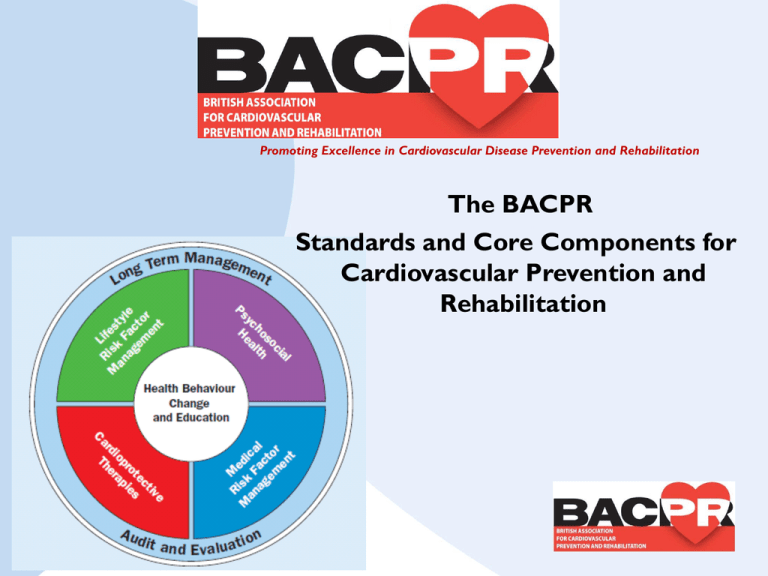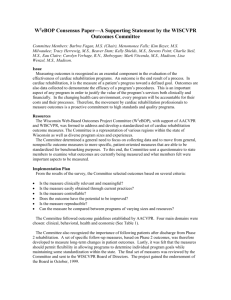BACPR Standards and Core Components Presentation Slides
advertisement

Promoting Excellence in Cardiovascular Disease Prevention and Rehabilitation The BACPR Standards and Core Components for Cardiovascular Prevention and Rehabilitation Overview Aim of the BACPR Standards and Core Components Background and evidence Introducing to the 2012 update of the BACPR Standards and Core Components Shaping future service delivery Aim This second edition of the BACPR Standards and Core Components aims to ensure programmes are clinically-effective, cost-effective and achieve sustainable health outcomes for patients. 7 core standards and 7 core components are set out which aim to improve uptake and quality of rehabilitation programmes nationwide www.bacpr.com Cardiac Rehabilitation defined by the WHO (1993) “The sum of activities required to influence favourably the underlying cause of the disease so that (people) may, by their own efforts preserve or resume when lost, as normal a place in the community… …it must be integrated within secondary prevention services of which it forms one facet.” The World Health Organisation (WHO). Cardiac rehabilitation and secondary prevention: long term care for patients with ischaemic heart disease. Briefing letter. Regional office for Europe: Copenhagen, Denmark; 1993. Modern cardiovascular prevention and rehabilitation Modern CR is menu-based and patient centred, and provides a pathway across the 7 stages from diagnosis to long term management. 2 5 Conduct final CR assessment Assess patient Patient presentation 0 Identify and refer patient 1 Manage referral and recruit patient Patient discharged 4 Deliver comprehensive *CR programme 3 Develop patient care plan 6 Discharge and transition to long term management Sharing cardiac rehabilitation information (education) and long-term management strategy with the patient *CR = cardiac rehabilitation *From DH Commissioning Pack: Service specification for cardiac rehabilitation 2010 The benefits of cardiac rehabilitation Reduces: All cause mortality by 11- 26% 1,2,3 Cardiac mortality by 26 – 36% 1,2,3 Morbidity 3,4 Unplanned admissions by 28 -56% 5,6 Improves: Quality of life 7 Functional capacity 7 Supports: Early return to work 7 The development of self-management skills 7 www.bacpr.com Cardiac Rehab is Cost Effective Cost to achieve adding 1 year to a patients life – PPCI – PCI – CABG – Cardiac Rehab – Aspirin/B-block £6,054 – 12,057 £3,845 – 5,889 £3239 – 4,601 £1,957 <£1,000 Fidan et al 2007 The future for CR Summary 1 CR is one of the most clinically and cost-effective therapeutic interventions in cardiovascular disease management More living and surviving with CVD or heightened risk of CVD Increased survival from CHD events means greater numbers with heart failure in future CR shifting from a “survival of the fittest” goal (reduced mortality) to one of prevention, chronic disease management and morbidity reduction UK Standards for CR – a brief history Number of cardiac rehabilitation programmes expanded rapidly during 1980s and 90s BACR formed in 1992 and recognised the importance of establishing guidelines for good practice – 1995 publication of BACR Guidelines for CR. BACR Standards 2007 Core components: Lifestyle: Physical activity and exercise Diet and weight management Smoking cessation Education Risk factor management Psychosocial Cardio protective drug therapy and implantable devices Long-term management strategy British Association for Cardiac Rehabilitation (BACR), Standards and Core Components for Cardiac Rehabilitation (2007). Date of Preparation: September 2009 OMA624 The NHS for the future Has to save money, not just be more cost effective Our goals for Cardiac rehab must include Preventing hospital re-admissions Preventing unnecessary appointments in primary care Educated patients knowing who to contact if symptoms or condition changes A focus on managing chronic disease linked with or causing CVD Changes to the Standards and Core Components Emphasis on: Patient-centred approach Biopsychosocial focus Multidisciplinary team work Health behaviour change and Education at core of all components – Recognition of the importance of audit and evaluation – Matched to DH Commissioning pack for CR – – – – BACPR Standards 2012 Patients, healthcare professionals and commissioners should expect the following from high quality cardiac rehabilitation services 1. The delivery of seven core components employing an evidence-based approach. 2. An integrated multidisciplinary team consisting of qualified and competent practitioners, led by a clinical coordinator. 3. Identification, referral and recruitment of eligible patient populations. 4. Early initial assessment of individual patient needs in each of the core components, ongoing assessment and reassessment upon programme completion. 5. Early provision of a cardiac rehabilitation programme, with a defined pathway of care, which meets the core components and is aligned with patient preference and choice. 6. Registration and submission of data to the National Audit for Cardiac Rehabilitation. 7. Establishment of a business case including a cardiac rehabilitation budget which meets the full service cost. Seven Core Components 1. Health behaviour change and education 2. Lifestyle risk factor management – Physical activity and exercise – Diet – Smoking cessation 3. 4. 5. 6. 7. Psychosocial health Medical risk factor management Cardioprotective therapies Long-term management Audit and evaluation The future for CR Summary 2 Ensuring referral of all eligible patients by cardiologists and/or specialist cardiovascular health care physicians to a prevention and rehabilitation programme as a standard (not optional) policy that is held in the same regard as the prescribing of cardioprotective medications. Tighter control of service audit (e.g. through NACR), not only to ensure these standards and core components are being met but to demonstrate that improved practice, clinical effectiveness and health outcomes have been achieved The continuing of a national campaign that raises the profile and need for comprehensive integrated cardiovascular prevention and rehabilitation programmes to be properly funded as a cost-effective means and obligatory element to any modern cardiology or vascular health care service. BACPR’s next steps Develop a set of performance indicators for the standards. Provide resources for service development e.g. tool-kits for business case development, exemplary assessment frameworks and mechanisms for effective knowledge transfer and training. Developing competency frameworks that are fully supported by high quality education and training programmes and research where required. • Support the uptake of CR in groups that are currently not represented or are under-represented • Edit a book from BACPR giving more detail on the “how to” of providing modern CR programmes. References from slide 4 1. Heran et al. Exercise-based cardiac rehabilitation for coronary heart disease. Cochrane Database of Systematic Reviews 2011, Issue 7. Art. No: CD001800. DOI: 10.1002/14651858.CD001800.pub2. 2. Taylor et al. Exercise-based rehabilitation for patients with coronary heart disease: systematic review and meta-analysis of randomized controlled trials. Am J Med 2004; 116(10):682-697. 3. Lawler et al. Efficacy of exercise-based cardiac rehabilitation post-myocardial infarction: A systematic review and meta-analysis of randomized controlled trials. Am Heart J Oct 2011; 162: 571-584. 4. Clark et al. Meta-Analysis: Secondary Prevention Programs for Patients with Coronary Artery Disease. Ann Intern Med 2005; 143(9): 659-672. 5. Lam et al. The effect of a comprehensive cardiac rehabilitation program on 60-day hospital readmissions after an acute myocardial infarction. J Am Coll Cardiol 2011; 57:597, doi:10.1016/S0735-1097(11)60597-4. 6. Davies et al. Exercise training for systolic heart failure: Cochrane systematic review and metaanalysis. Eur J Heart Fail 2010; 12(7): 706-715. 7. Yohannes et al.. The long-term benefits of cardiac rehabilitation on depression, anxiety, physical activity and quality of life. Journal of Clinical Nursing 2010; 19(19-20):2806-2813.









